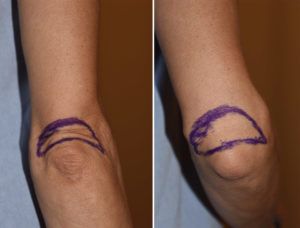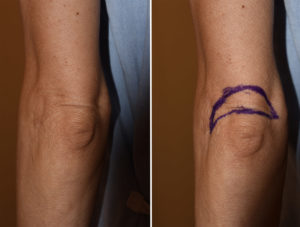Background: Collections of excess skin rolls all over the body occurs from a variety of conditions. The most common is from aging with weight loss being a second source of its occurrence. While such rolls of skin can be aesthetically bothersome for some people, others accept it as a natural body process.
One very unique body area for skin rolls to develop is on the mid-joint of the extremities. At the elbows and knees, which have a wide range of motion of just over 160 degrees, skin rolls develop by the repeated joint motion over time. These skin rolls appear at top of the joint when it is in full extension and ‘disappear’ when the joint undergoes flexion. This means they appear at the back of the elbow and at the top of the knees.
Treatment of these joint-related skin rolls is difficult as no non-surgical therapies for skin tightening will not work. Liposuction provides no benefit since the cause is not fat-based and often makes look even worse with the volume deflation. Fat injections may have a plumping effect but this often ends up looking swelling and fat survival is poor is any area of high motion.
Case Study: This middle-aged female was bothered by the rolls of skin that had developed on the back of her elbows. She was a very thin female with small arms with little subcutaneous fat. She felt that the trade-off of a scar above the elbow was better than the appearance of the skin rolls.


The elbow lift is the smallest of all body lift procedures. It is a small surgery with fairly easy recovery. While very effective at removing the skin rolls, one must have a strong belief that the scar is better than the skin rolls. To avoid wide or hypertrophic scarring, the tissue excision pattern must take into account the flexion motion of the elbow joint to avoid over resection, a very tight closure and a subsequent wide scar.
Highlights:
- The folds of skin above the elbow with aging can be treated by an excisional approach.
- Elbow lifts should the marked and performed with the arm in a 90 degree flexion at the elbow to avoid wide postoperative scarring.
- The decision for an elbow lift is based on whether the scar tradeoff is worthy one.
Dr. Barry Eppley
Indianapolis, Indiana



